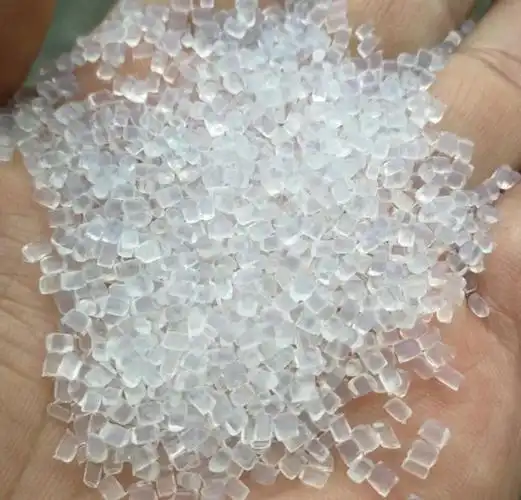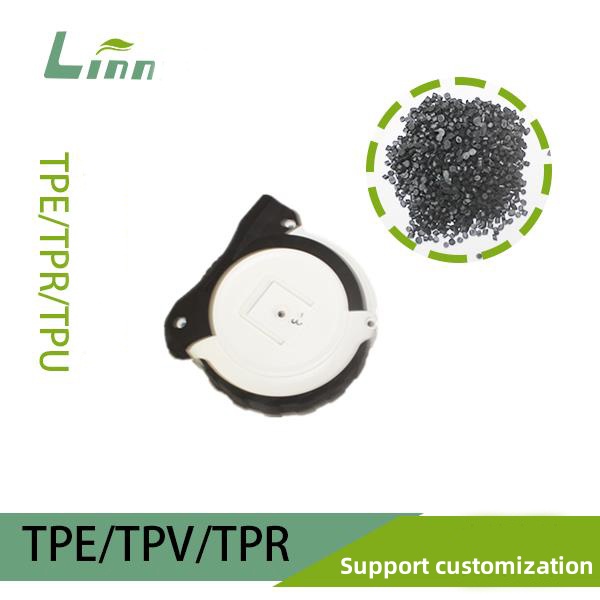As someone who’s spent years working with thermoplastic elastomers (TPEs) in manufacturing, I’ve seen firsthand how critical temperature control is to producing high-quality parts. Whether you’re new to TPEs or a seasoned engineer troubleshooting a production line, getting the temperature settings right can make or break your final product. TPEs are versatile materials, blending the flexibility of rubber with the processability of plastics, but their sensitivity to heat demands precision. Today, I’ll share practical insights on the temperature ranges for TPE production, drawing from my experience and industry standards, to help you achieve consistent, high-quality results.

Understanding TPE and Its Processing Needs
TPEs, or thermoplastic elastomers, are a class of materials that combine the elasticity of rubber with the ability to be molded and remolded like thermoplastics. They’re widely used in industries like automotive, medical, and consumer goods for parts like seals, gaskets, and soft-touch grips. Unlike thermoset rubbers, TPEs don’t require chemical crosslinking, which simplifies processing but makes temperature control critical. Too low, and the material won’t flow properly; too high, and you risk degradation, affecting both appearance and performance.
In my early days in the factory, I remember a batch of TPE seals coming out brittle because we underestimated the melting temperature. It was a costly lesson, but it drove home the importance of tailoring temperatures to the specific TPE type and processing method. Let’s break down the key factors and typical temperature ranges to guide your production setup.
Key Factors Influencing TPE Production Temperatures
Before diving into specific numbers, it’s worth noting that TPEs aren’t a one-size-fits-all material. Different TPE families—like styrenic block copolymers (TPE-S), thermoplastic polyurethanes (TPU), thermoplastic vulcanizates (TPV), and thermoplastic copolyesters (TPE-E)—have unique thermal properties. Here are the main factors that determine the right temperature settings:
Material Composition: The ratio of hard and soft segments in TPEs affects their melting point and flow behavior. For example, TPUs with polyester-based structures often require higher temperatures than styrenic TPEs.
Processing Method: Whether you’re using injection molding, extrusion, or blow molding, each method has distinct temperature requirements due to differences in shear rates and cooling times.
Equipment Specifications: The design of your machine, such as barrel size or screw configuration, can influence how heat is distributed to the material.
Additives and Fillers: Some TPE grades include fillers like glass fibers or plasticizers, which can alter the processing window.
In my experience, always consult the material supplier’s technical data sheet (TDS) first. These sheets provide recommended temperature ranges tailored to the specific grade, but real-world adjustments are often needed based on your setup.
Typical Temperature Ranges for TPE Processing
Let’s get to the core of the question: what temperatures should you set for TPE production? The answer depends on the TPE type and processing method. Below, I’ve compiled a table summarizing typical melt and mold temperature ranges for common TPE families, based on my work and industry references. These are starting points, and fine-tuning is often necessary.
|
TPE Type |
Melt Temperature (°C) |
Mold Temperature (°C) |
Typical Applications |
|---|---|---|---|
|
TPE-S (SBS/SEBS) |
150–200 | 20–50 |
Soft grips, seals, toys |
|
TPU (Polyurethane) |
180–230 | 30–60 |
Medical tubing, cable jackets |
|
TPV (PP/EPDM) |
170–220 | 25–55 |
Automotive seals, gaskets |
|
TPE-E (Copolyester) |
200–250 | 40–70 |
High-performance hoses, belts |
TPE-S (Styrenic Block Copolymers)
TPE-S, like SBS or SEBS, is one of the most common TPE types due to its affordability and versatility. In my factory days, we used TPE-S for soft-touch handles, and I found that setting the barrel temperature between 150–200°C worked well for injection molding. The mold itself was kept cooler, around 20–50°C, to ensure rapid solidification without warping. If the melt temperature crept above 210°C, we’d notice degradation, leading to a burnt smell and discolored parts.

TPU (Thermoplastic Polyurethane)
TPUs are trickier because they’re sensitive to moisture and high heat. I recall a project where we molded TPU medical tubing, and we had to dry the material thoroughly at 80–100°C for 2–3 hours before processing to avoid bubbles. The melt temperature was set at 180–230°C, depending on whether it was polyester- or polyether-based. Mold temperatures around 30–60°C helped achieve smooth surfaces and consistent elasticity.
TPV (Thermoplastic Vulcanizates)
TPVs, often used in automotive seals, combine polypropylene with cross-linked EPDM rubber. I’ve worked with TPVs for weatherstrips, and we typically set melt temperatures between 170–220°C. Keeping the mold at 25–55°C ensured the parts retained their shape without sticking. One tip: TPVs can handle slightly higher temperatures than TPE-S, but exceeding 230°C risks breaking down the rubber component, leading to poor mechanical properties.
TPE-E (Thermoplastic Copolyesters)
TPE-Es, like Hytrel or Arnitel, are high-performance materials used in demanding applications like hoses. In one project, we molded TPE-E belts, and the melt temperature needed to be 200–250°C to achieve proper flow. The mold was kept at 40–70°C to balance cooling time and surface quality. These materials can withstand higher temperatures, but I’ve seen overheating above 260°C cause yellowing and loss of elasticity.
Processing Methods and Temperature Considerations
The way you process TPEs significantly impacts temperature settings. Here’s how I’ve approached the main methods:
Injection Molding: This is the most common method for TPEs due to its precision. I always start with the lower end of the melt temperature range to avoid degradation, gradually increasing until the material flows smoothly. For example, with TPE-S, I’d begin at 160°C and adjust up to 190°C if needed. Mold temperatures are kept low to speed up cycle times, but too cold, and you’ll get incomplete mold filling.
Extrusion: Extrusion requires a more gradual temperature profile across the barrel zones. For TPUs, I’ve used a profile starting at 170°C in the feed zone, rising to 210°C at the die. Keeping the die slightly cooler than the barrel prevents sticking and ensures a smooth extrudate.
Blow Molding: Less common for TPEs, but when used (e.g., for TPU bellows), I’ve set melt temperatures slightly higher than injection molding, around 190–240°C, to ensure good parison formation. Mold temperatures stay in the 30–60°C range.
In all cases, I recommend running test batches to fine-tune settings. Equipment differences, like screw design or cooling efficiency, can shift the optimal range by 5–10°C.
Practical Tips from the Field
Over the years, I’ve picked up a few tricks that can save you headaches when setting TPE production temperatures:
Pre-Dry the Material: TPEs, especially TPUs, absorb moisture, which can cause defects like bubbles or splay. I always dry TPEs at 80–100°C for 2–4 hours before processing, checking the material’s moisture content with a meter if possible.
Monitor Barrel Residence Time: Long residence times at high temperatures can degrade TPEs. I once had a batch of TPV parts turn brittle because the material sat in the barrel too long. Keep cycle times tight, and purge the machine if production pauses.
Adjust for Additives: If your TPE contains fillers like glass fibers, you may need to increase the melt temperature slightly (e.g., 5–10°C higher) to compensate for reduced flowability.
Cool Gradually: Rapid cooling can cause internal stresses, especially in thicker parts. I’ve found that setting the mold temperature on the higher end of the range (e.g., 50°C for TPU) reduces warping.
Check for Degradation: If you notice a burnt smell, discoloration, or reduced elasticity, your temperatures are likely too high. Lower the melt temperature by 10°C increments and retest.

Common Challenges and How to Address Them
Even with the right temperature settings, TPE production can throw curveballs. Here are some issues I’ve encountered and how I solved them:
Poor Surface Finish: If parts look streaky or rough, the melt temperature might be too low, causing incomplete flow. Increase it by 5–10°C or check for moisture in the material.
Warping or Shrinkage: This often stems from uneven cooling. I’ve adjusted mold temperatures to be slightly higher (e.g., 40–50°C for TPE-S) and ensured uniform cooling across the mold.
Material Sticking to the Mold: This is common with TPVs if the mold is too warm. Lower the mold temperature by 5–10°C or apply a mold release agent sparingly.
Brittle Parts: Overheating is usually the culprit. I once had a batch of TPU parts fail because the melt temperature hit 240°C. Dropping it to 220°C and drying the material fixed the issue.
Environmental and Equipment Considerations
Your production environment and equipment play a big role in temperature settings. In humid climates, like the factories I’ve worked in near coastal areas, moisture control is critical. A dehumidifying dryer is a worthwhile investment for TPEs. Similarly, older machines with less precise temperature controls can lead to inconsistent results. I’ve had to calibrate barrel heaters regularly to avoid hot spots, which can degrade TPEs unevenly.
If you’re working with a new TPE grade, don’t assume your existing settings will work. I once switched to a glass-filled TPU and had to increase the melt temperature by 15°C to account for its higher viscosity. Always start with the supplier’s TDS and adjust based on trial runs.
Advanced Considerations for High-Performance TPEs
For high-performance applications, like automotive hot charge air ducts, specialized TPEs like Arnitel HT can handle continuous temperatures up to 180°C and peaks of 190°C. In one project, we used Arnitel HT for blow-molded ducts, setting the melt temperature at 230–250°C to achieve the necessary flow while keeping the mold at 50–70°C for dimensional stability. These materials demand precise control, as even small deviations can affect performance under extreme conditions.
Another advanced TPE I’ve worked with is glass fiber-reinforced TPU, which can withstand up to 170°C in service. For processing, we used melt temperatures of 220–240°C and mold temperatures of 40–60°C to balance strength and surface quality. These materials are pricier, so getting the settings right the first time is crucial to avoid waste.

Wrapping Up: Fine-Tuning for Success
Setting the right production temperatures for TPEs is both an art and a science. Start with the recommended ranges from the material supplier, but don’t be afraid to experiment within a 5–10°C window to optimize for your specific setup. From my years on the factory floor, I can tell you that small adjustments—coupled with careful monitoring of material condition, equipment performance, and environmental factors—can dramatically improve your results. Whether you’re molding soft grips or extruding medical tubing, mastering temperature control will help you produce TPE parts that are consistent, durable, and cost-effective.
If you’re struggling with a specific TPE grade or process, feel free to share more details, and I can offer tailored advice based on my experience. The key is to stay patient, test systematically, and always keep an eye on the material’s behavior.
Related Questions and Answers
Q: Why do my TPE parts have bubbles or voids?
A: Bubbles often result from moisture in the material. Dry the TPE at 80–100°C for 2–4 hours before processing. Also, check if the melt temperature is too high, causing gas entrapment—try lowering it by 5–10°C.
Q: How do I know if my TPE is overheating?
A: Look for signs like a burnt smell, yellowing, or brittle parts. If you notice these, reduce the melt temperature by 10°C increments and ensure the material isn’t sitting in the barrel too long.
Q: Can I use the same temperature settings for different TPE types?
A: No, each TPE type (TPE-S, TPU, TPV, TPE-E) has unique thermal properties. Always refer to the supplier’s TDS and adjust based on your equipment and processing method.
Q: What’s the best way to cool TPE parts after molding?
A: Use a mold temperature within the recommended range (e.g., 20–50°C for TPE-S) and avoid rapid cooling to prevent internal stresses. For thicker parts, slightly higher mold temperatures can help.
Q: How do additives affect TPE processing temperatures?
A: Additives like glass fibers or plasticizers can increase viscosity, requiring a slight increase in melt temperature (e.g., 5–10°C). Check the TDS for guidance and test small batches first.





